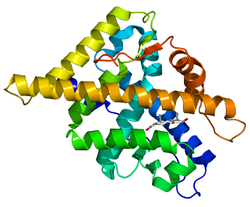
Androgen receptor

1E3G, 1GS4, 1T5Z, 1T63, 1T65, 1XJ7, 1XOW, 1XQ3, 1Z95, 2AM9, 2AMA, 2AMB, 2AO6, 2AX6, 2AX7, 2AX8, 2AX9, 2AXA, 2HVC, 2OZ7, 2PIO, 2PIP, 2PIQ, 2PIR, 2PIT, 2PIU, 2PIV, 2PIW, 2PIX, 2PKL, 2PNU, 2Q7I, 2Q7J, 2Q7K, 2YHD, 2YLO, 2YLP, 2YLQ, 2Z4J, 3B5R, 3B65, 3B66, 3B67, 3B68, 3BTR, 3V49, 3V4A, 3ZQT, 4HLW, 3L3X, 3L3Z, 3RLJ, 3RLL, 4K7A, 4OEA, 4OED, 4OEY, 4OEZ, 4OFR, 4OFU, 4OGH, 4OH5, 4OH6, 4OHA, 4OIL, 4OIU, 4OJ9, 4OJB, 4OK1, 4OKB, 4OKT, 4OKW, 4OKX, 4OLM, 4QL8, 5CJ636711835n/aENSMUSG00000046532P10275P19091NM_001011645NM_000044NM_013476NP_000035.2NP_001011645.1NP_038504The androgen receptor (AR), also known as NR3C4 (nuclear receptor subfamily 3, group C, member 4), is a type of nuclear receptor that is activated by binding any of the androgenic hormones, including testosterone and dihydrotestosterone in the cytoplasm and then translocating into the nucleus. The androgen receptor is most closely related to the progesterone receptor, and progestins in higher dosages can block the androgen receptor. The androgen receptor (AR), also known as NR3C4 (nuclear receptor subfamily 3, group C, member 4), is a type of nuclear receptor that is activated by binding any of the androgenic hormones, including testosterone and dihydrotestosterone in the cytoplasm and then translocating into the nucleus. The androgen receptor is most closely related to the progesterone receptor, and progestins in higher dosages can block the androgen receptor. The main function of the androgen receptor is as a DNA-binding transcription factor that regulates gene expression; however, the androgen receptor has other functions as well. Androgen regulated genes are critical for the development and maintenance of the male sexual phenotype. In some cell types, testosterone interacts directly with androgen receptors, whereas, in others, testosterone is converted by 5-alpha-reductase to dihydrotestosterone, an even more potent agonist for androgen receptor activation. Testosterone appears to be the primary androgen receptor-activating hormone in the Wolffian duct, whereas dihydrotestosterone is the main androgenic hormone in the urogenital sinus, urogenital tubercle, and hair follicles. Testosterone is therefore responsible primarily for the development of male primary sexual characteristics, whilst dihydrotestosterone is responsible for secondary male characteristics. Androgens cause slow epiphysis, or maturation of the bones, but more of the potent epiphysis effect comes from the estrogen produced by aromatization of androgens. Steroid users of teen age may find that their growth had been stunted by androgen and/or estrogen excess. People with too little sex hormones can be short during puberty but end up taller as adults as in androgen insensitivity syndrome or estrogen insensitivity syndrome. Also, AR knockout-mice studies have shown that AR is essential for normal female fertility, being required for development and full functionality of the ovarian follicles and ovulation, working through both intra-ovarian and neuroendocrine mechanisms. Via the androgen receptor, androgens play a key role in the maintenance of male skeletal integrity. The regulation of this integrity by androgen receptor (AR) signaling can be attributed to both osteoblasts and osteocytes. The primary mechanism of action for androgen receptors is direct regulation of gene transcription. The binding of an androgen to the androgen receptor results in a conformational change in the receptor that, in turn, causes dissociation of heat shock proteins, transport from the cytosol into the cell nucleus, and dimerization. The androgen receptor dimer binds to a specific sequence of DNA known as a hormone response element. Androgen receptors interact with other proteins in the nucleus, resulting in up- or down-regulation of specific gene transcription. Up-regulation or activation of transcription results in increased synthesis of messenger RNA, which, in turn, is translated by ribosomes to produce specific proteins. One of the known target genes of androgen receptor activation is the insulin-like growth factor I receptor (IGF-1R). Thus, changes in levels of specific proteins in cells is one way that androgen receptors control cell behavior. One function of androgen receptor that is independent of direct binding to its target DNA sequence, is facilitated by recruitment via other DNA-binding proteins. One example is serum response factor, a protein that activates several genes that cause muscle growth. Androgen receptor is modified by post translational modification through acetylation, which directly promotes AR mediated transactivation, apoptosis and contact independent growth of prostate cancer cells. AR acetylation is induced by androgens and determines recruitment into chromatin. The AR acetylation site is a key target of NAD-dependent and TSA-dependent histone deacetylases and long non coding RNA.
